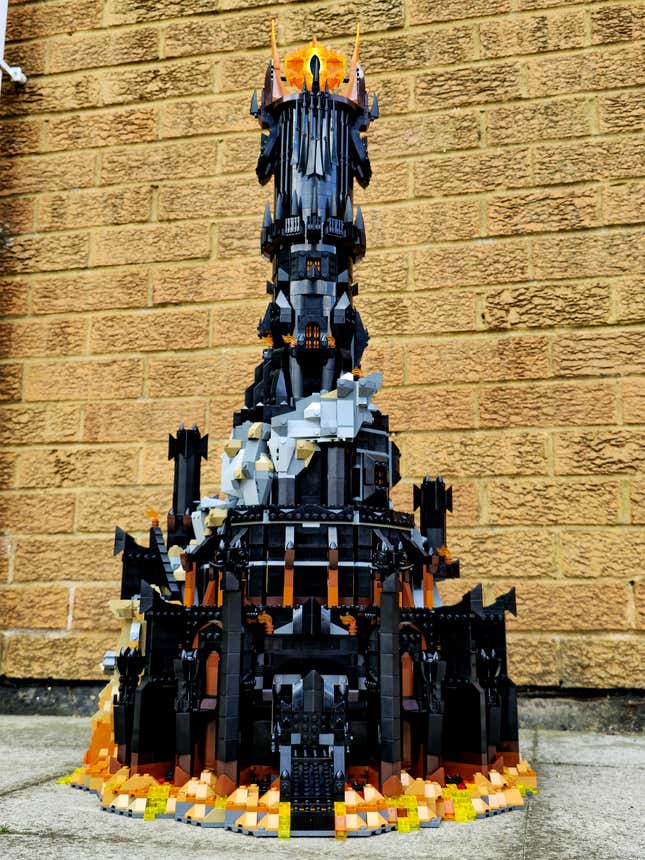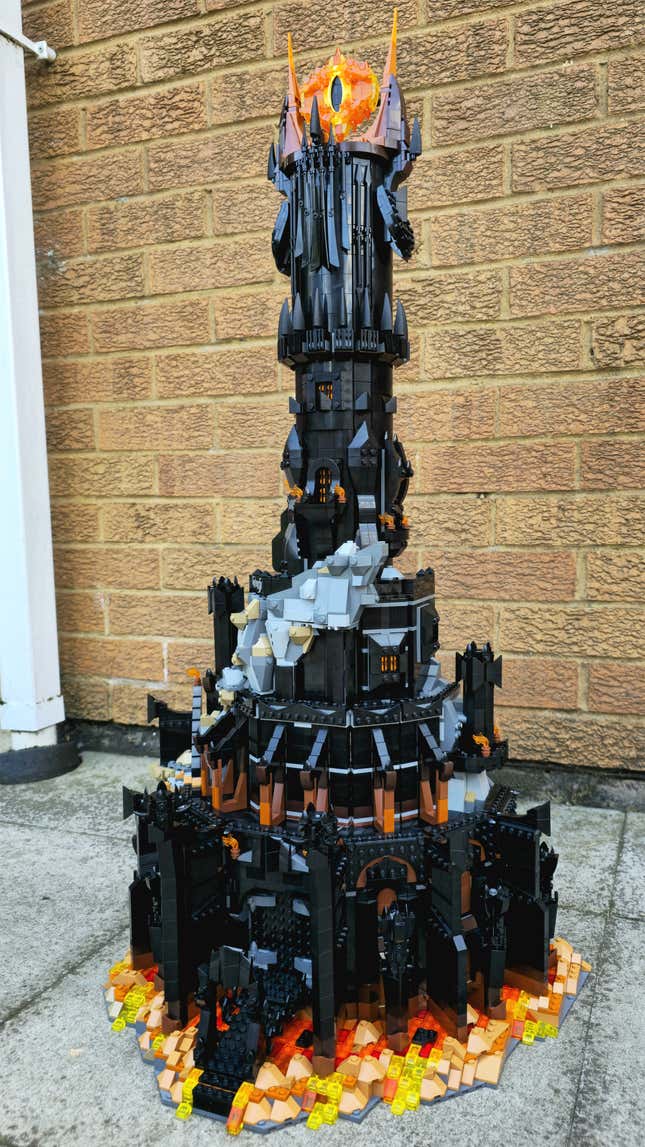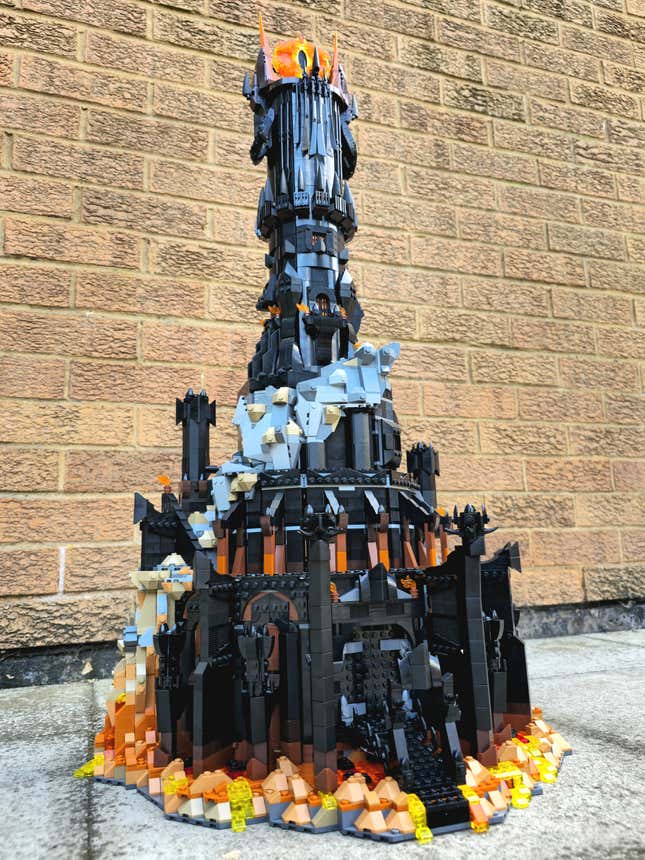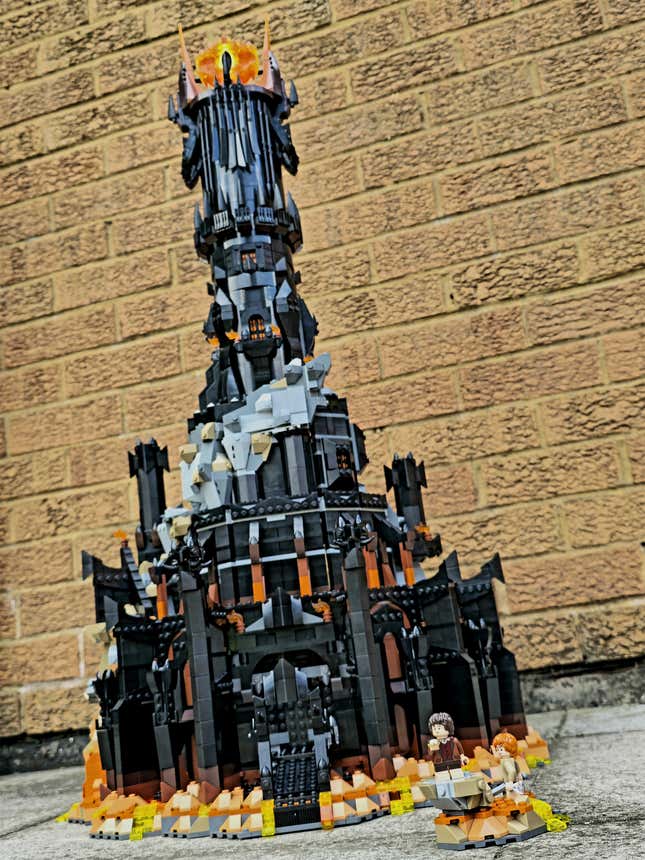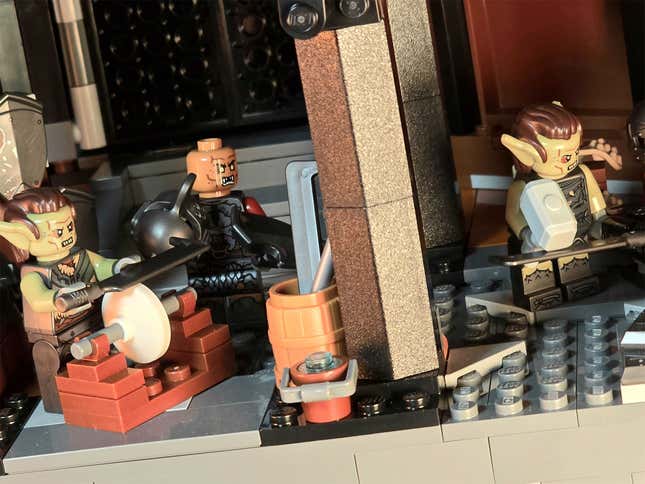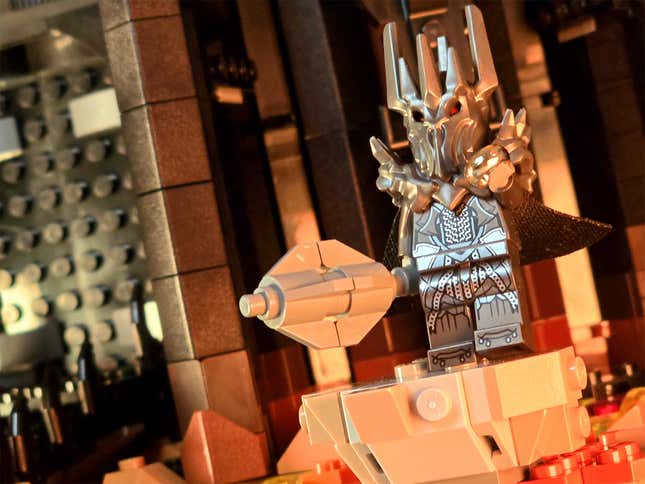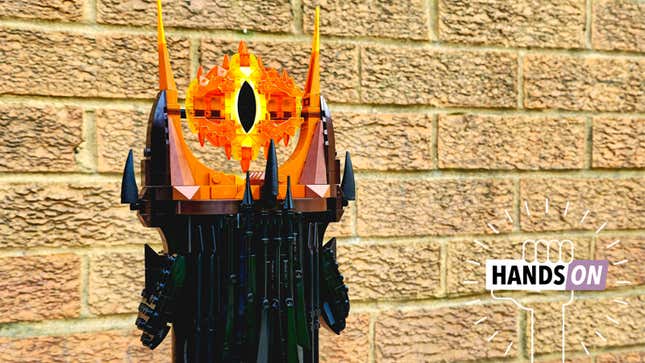
Last year, Lego returned after years away to the realm of Middle-earth, delivering one of the most remarkable sets it’s ever made in in Rivendell, a gorgeous tribute to The Lord of the Rings. Now, it’s headed there and back again, with a darker bent—but does heading to the land of Mordor, where shadows lie, reap the rewards?
Recently Lego provided io9 with its latest Lord of the Rings set, Barad-Dûr—Sauron’s black seat of power at the heart of his evil domain. After a few days toiling away—just a bit less than the 600 or so years it took Sauron’s forces to build the tower in the books—we’re here to report on what works with the brickmaker’s latest set, what doesn’t, and if it’s a worthy follow up to the glimmering house of Imladris.
How long does it take to build Lego’s Lord of the Rings Barad-Dûr set?
Clocking in at 5,471 pieces, the Lego Barad-Dûr set is around 700 or so pieces smaller than last year’s Rivendell set. It’s also, by its design—as we’ll get into shortly—a simpler build than that set was, trading the intricacies of Elven architecture for the stark, largely black structure of a spiked tower. That means that, despite still being a pretty huge kit, it actually doesn’t take remotely as long to put together. Well, remotely in the grand scheme of things: at around 10-15 hours, depending on pace, you can still probably chug your way through a marathon re-watch of the Lord of the Rings extended editions while you work. You probably won’t have time to dig into The Hobbit ones though, for better or worse.
How many minifigures are in Lego’s Lord of the Rings Barad-Dûr set?
Barad-Dûr includes 10 minifigures: six named characters and four generic ones. For the known characters there’s Frodo, Sam, and Gollum, and then three named villains in Sauron (as he appears in physical form in Fellowship of the Ring’s opening), the Mouth of Sauron, and Lieutenant Gothmog, the Orcish commander of Mordor’s siege of Minas Tirith. Rounding out the collection are four generic orcs from Mordor’s hosts. Parts are included to mix and match helmets for all four of them, but two are built with accessories to make them occupy specific roles in Barad-Dûr—one has the tools of a blacksmith for the tower’s forges, and the other… is an Orcish chef, for the tower’s surprisingly detailed dining hall?
While Sam and Frodo were already minifigures included in Rivendell last year—no changes were made to update their attire based on their arrival in Mordor during Return of the King—the set marks the first time Lord of the Rings fans have been able to get a minifigure-scaled Sauron at all. It also brings back access to figures like Gollum and the Mouth of Sauron that were part of Lego’s original Lord of the Rings line before it came to an end in 2015. It’s access that’ll cost you a lot, sure, but it’s probably better than the aftermarket on some of those rare minifigures is now.
One more minifigure is included if you buy Barad-Dûr directly from Lego between June 1 and June 7: a Nazgul, who rides the accompanying bonus Fell Beast set included as an extra gift (io9 did not receive one for review).
Is Lego’s Lord of the Rings Barad-Dûr set difficult to build?
Whether you’re a seasoned Lego builder or a more occasional dabbler, despite its impressive scale, Barad-Dûr is a deceptively simple building experience. Broken down into four sections—the base level and forge, two mid-tier structures housing a dining hall and Sauron’s throne, and then the tower itself—across three manuals of instructions, it’s pretty easy build as a modular experience, and with a lot of repeated steps and techniques to create the outer structure, finding a rhythm to putting it all together in spite of the parts count isn’t too difficult.
But that simplicity occasionally comes with a price—the outside of Barad-Dûr looks great, but the interior features are a little plain, and don’t have too much space to use, leading to moments in the build process that break up the patterns and color monotony of the exterior, but don’t really add much excitement to the process.
Is Lego’s Barad-Dûr set better for Lego fans or Lord of the Rings fans?
Unlike Rivendell last year, Barad-Dûr doesn’t really offer that much that’s unique as a build to excite diehard Lego fans who may not necessarily care about The Lord of the Rings. It’s quite a monotonous build thanks to all the black, even though the set actually does some really clever things with color to recreate the fiery glow around the lava at the tower’s base, and Sauron’s flaming eye, but that’s a subtle enough distinction that it’s easy to brush over beyond the moment-to-moment building. There’s no particularly unique architecture or structure compared to something like Rivendell’s rooftops that stand out as an interesting highlight in the build, and the interior play aspects feel a bit weird for a set that is aimed at collectors and display. But it’s a nice-looking thing when built, and at just over 32 inches high, it’s incredibly impressive to gaze upon (while you figure out where the hell you’re going to put it on display, that is) when it’s finished.
For Lord of the Rings fans, there’s a lot of little details to love however—little references to the films are littered throughout the interior, like a gag chalkboard in the dining hall that indicates to the boys that meat is indeed back on the menu. It’s a fantastic representation of the Barad-Dûr design we see in the films, and there’s great minifigure choices here that bring some iconic villain designs to bricky life. But while it’s cool to see a villain-oriented set like this get made, if you had to pick between this or Rivendell as the Lego set to get as a Lord of the Rings fan, the latter remains a better pick, in terms of the characters it has, its nature as a display piece, and all the intricate details that make it feel worth that hefty price tag.
How much is Lego’s Lord of the Rings Barad-Dûr set? Is it worth the price?
At $460, Barad-Dûr might seem relatively tame when it comes to some of the crazy prices Lego’s most lavish sets have commanded lately. And it does a lot to justify it in terms of its size and scope and looking the part it needs to. But again, you cannot help but draw comparisons to last year’s Rivendell set, and there, Barad-Dûr feels a little wanting.
Rivendell, which is still available through Lego, cost $40 more, came with five more minifigures, and around 700 or so more pieces. And while sheer number counts don’t make for all that compelling a comparison—there certainly doesn’t feel like a 700-ish-piece difference between the two—Rivendell’s minifigure choice is immaculate, delivering every iconic character you’d want from the set and then some, on top of being a much stronger build experience that results in a gorgeous display piece. We’re at a niche of a niche here in the realm of Lord of the Rings fans interested in Lego who can throw down a good chunk of money on a lavish set—and Barad-Dûr takes that niche a step further in explicitly being dedicated to people interested in the more sinister side of Middle-earth. And even then, the set itself feels like it’s struggling to justify itself: from the front, a stunning display piece every bit worthy of the scale and scope, and from the back, a half-hearted series of smaller play set vignettes that feel undercooked for a set at this price and aimed at adult collectors.
Perhaps it’s fitting that a set themed around Mordor often feels like it’s clouded in shadow, no matter what it does to stand tall on its own. If you already have Rivendell, then it’s great news: Barad-Dûr is a really fun set that will make a fine addition to what is probably going have to be a very large shelf in your collection. But if you’re a Lego Lord of the Rings fan who wants to finally bite the bullet and has to pick one or the other of these similarly-enough priced and sized sets? As good as Barad-Dûr is, Rivendell remains the the one to go for.
Lego’s Lord of the Rings Barad-Dûr set will release June 1 for Lego Insiders, and widely a few days later on June 4. Click through to see more of our thoughts breaking down the set section by section—and plenty more pictures to boot.
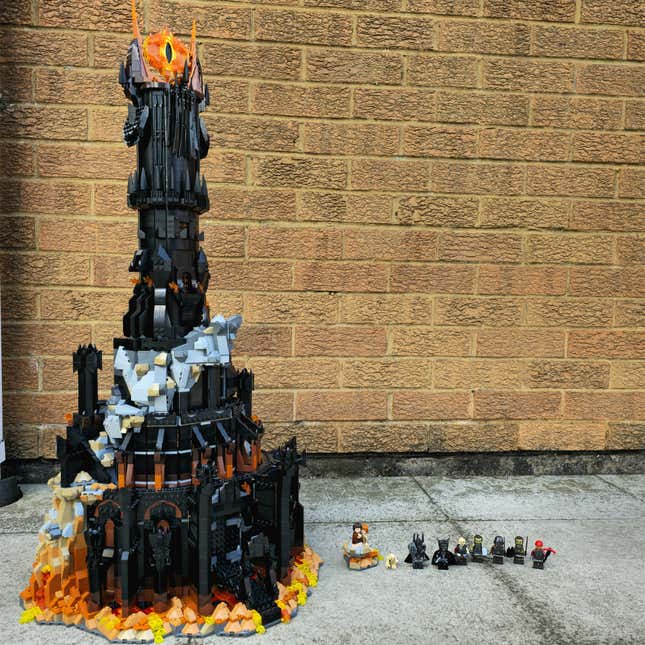
Barad-Dûr cuts an impressive appearance in its final form (I cannot stress enough how much this completed tower is almost half my height, and I’m a remarkably average-sized man). But perhaps my favorite part of the whole thing isn’t even the tower itself, but the little platform of lava-licked rock you get to portray the interior of Mount Doom as an an accompanying piece.

On the backside, Barad-Dûr is a little less impressive—cut away to give you tiered access to five distinct areas.
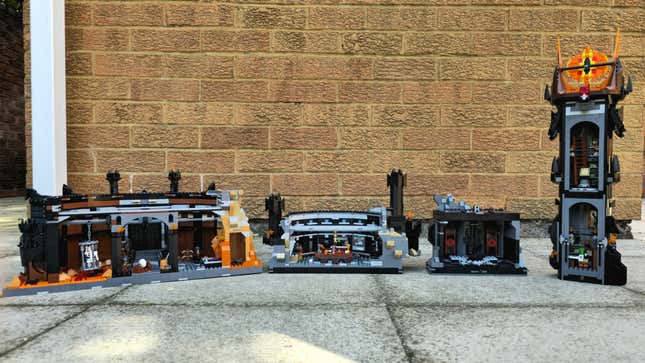
The kit itself is built, and can be broken down into, four distinct stages, and when locked in together they make for a sturdy display, in spite of the height.
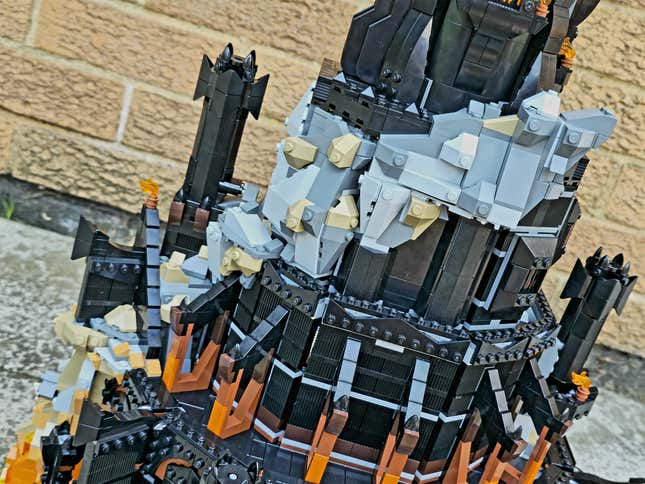
The rocky details cutting a gash across the lower levels of the tower are built up across the first three levels of the build, and help break up the repetition of a lot of black parts on black parts.
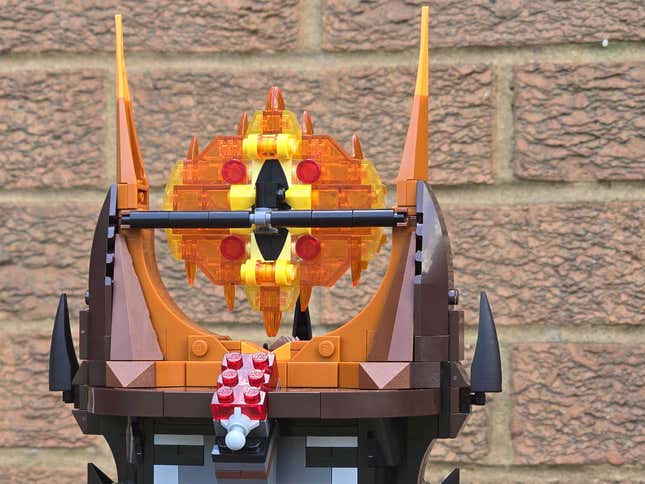
Hidden behind Sauron’s flaming eye—which is surprisingly articulated, and can be rotated up and down as well as side to side—is an LED light brick to bathe the eye in red light. It’s a bit awkward, however: you have to hold down the button on the brick to keep it active, and honestly the light doesn’t add all that much to the actual excellent appearance of the Eye itself.
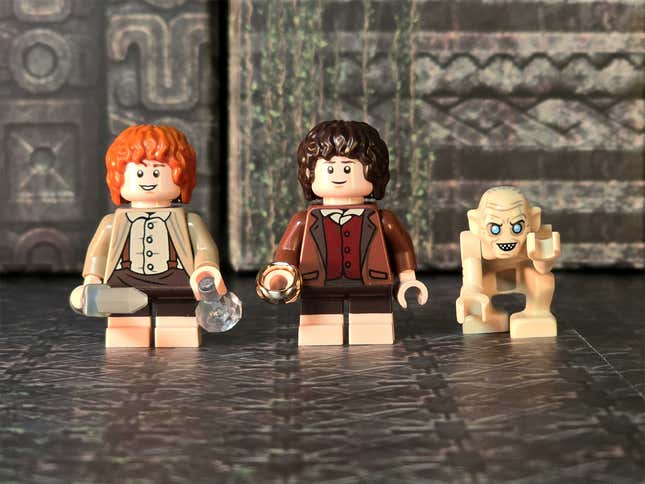
Before we take a closer look at the set itself, here’s the minifigures included, starting with the heroes (and hero-adjacent). Sam and Frodo are the same as they were in Rivendell, although Sam does get one new accessory appropriate for venturing into Mordor: a crystal piece representing the Phial of Galadriel, which he uses to beat back Shelob at Cirith Ungol in Return of the King. The Gollum minifigure hasn’t changed since it was last seen in the Hobbit Lego releases, except it has new printing.
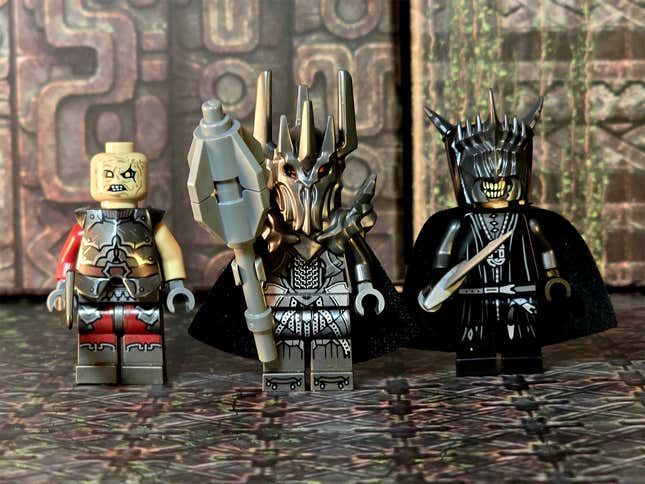
Three named characters are included for the bad guys: Gothmog, Sauron, and the Mouth of Sauron, from Return of the King’s deleted scenes. The all-new Sauron minifigure is fantastic, especially his giant mace. There’s actually a ton of fiery detail printed on the head beneath the helmet, too!
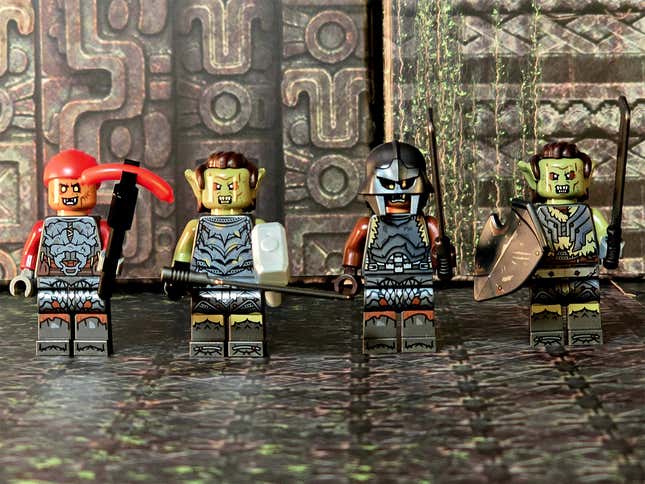
The forces of Mordor are rounded out by four orcs. While there are parts and accessories littered throughout the set to mix and match them all, two are built initially as general footsoldiers, while two are given specific roles: a hot dog wielding cook, and a smith hammering away at an orcish sword under construction.
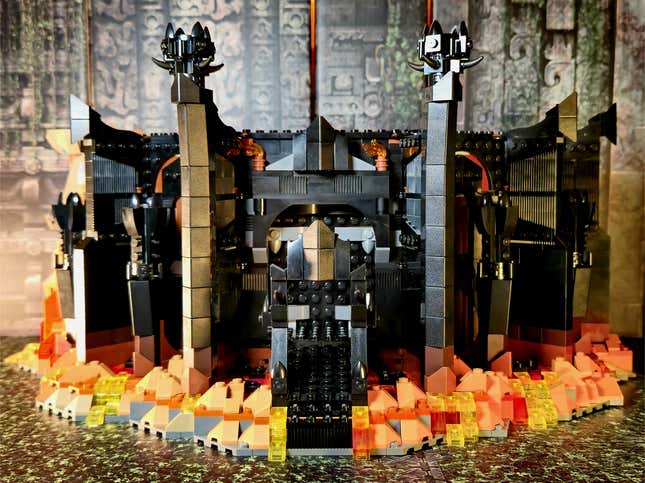
The build begins, of course, from the ground up, starting with the entrance to Barad-Dûr. The lava-littered base is really impressive, and looks fantastic.
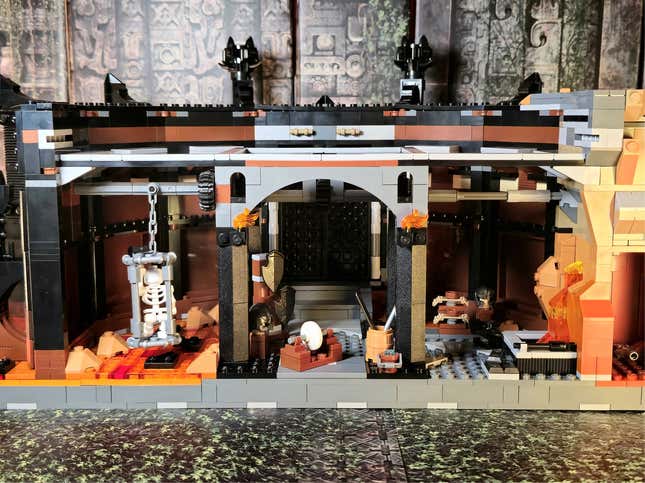
Turning around this base section lets you see a nice little forge area, fitting as Barad-Dûr is the heart of Sauron’s forces. A ton of the accessories put here can be used to change up your various orcs, and hidden in the rafters are the mechanics to open the gates of Barad-Dûr with the twist of a rock built into the right side of the tower.
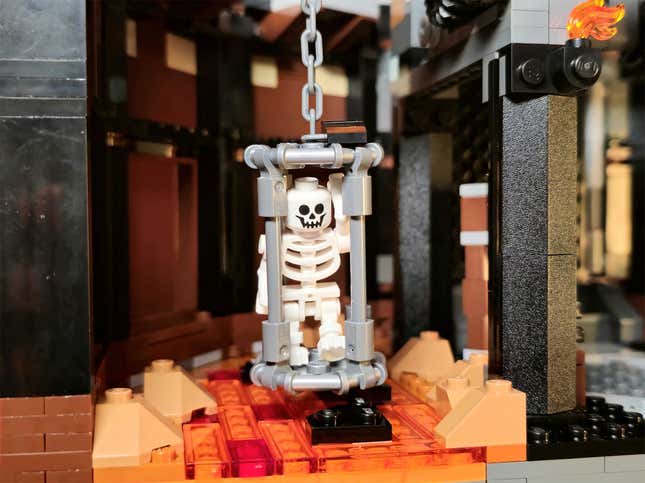
Speaking of little mechanics, there’s also a simple gear that can raise or lower this poor imprisoned skeleton closer or further away from the fires below.
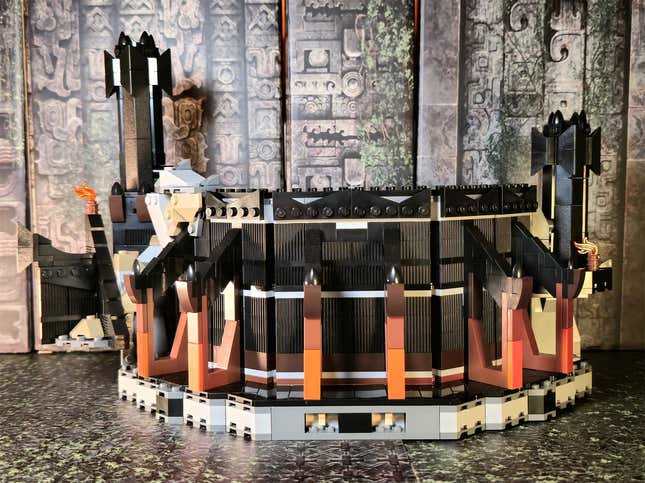
The second section, on the exterior at least, makes clever uses of brown and orange pieces to replicate the glow from the lava flowing in and around Barad-Dûr’s base. It’s effective and makes the final display really come together instead of just being 100% black.
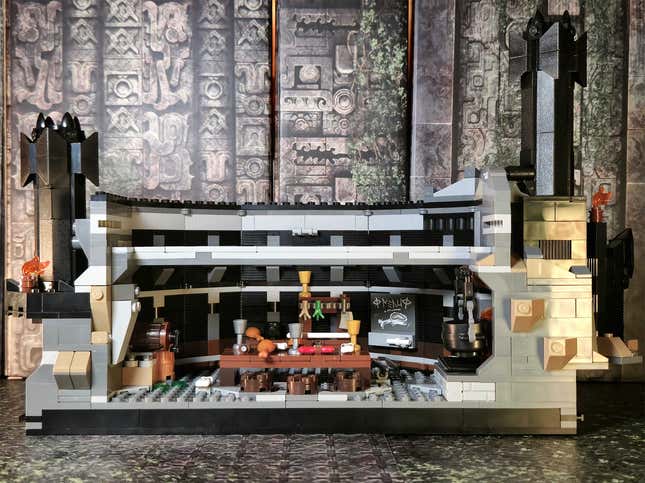
Turning around the second section gives you a peculiar addition: a small, but relatively resplendent kitchen and dining area, complete with kegs of mysterious drinks, tons of meat, and even separate cooking and prep areas. Food and the preparation of it is a key bit of symbolic imagery in Lord of the Rings, one that defines a shared sense of humanity—so it’s interesting to see that experience reflected on the forces of Mordor.
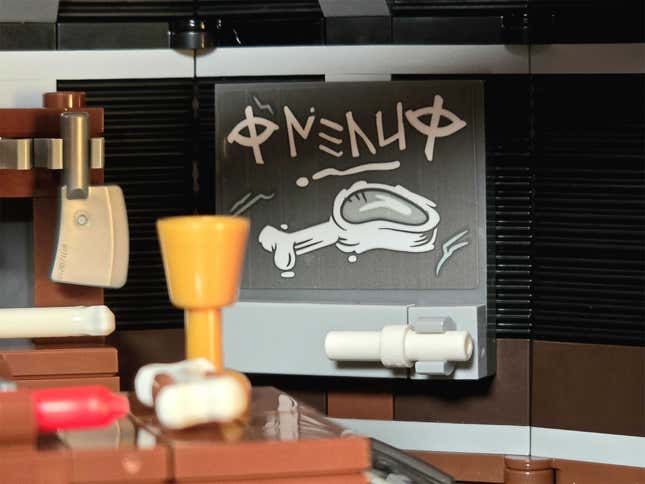
This is my favorite gag in the whole set. Simple, but effective as a call back to an oft-memed line.
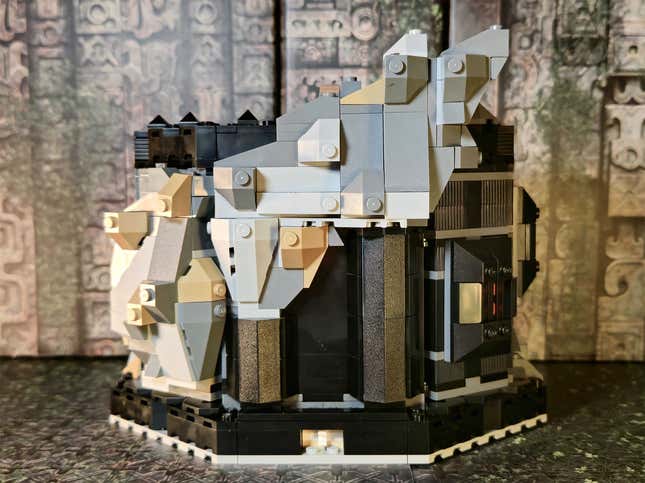
The higher the tower goes up, the smaller the sections become—but the exterior here makes up the bulk of that previously mentioned cool rocky outcropping.

Inside, we get a bit more imagined on behalf of Lego’s designers: Barad-Dûr is an iconic image from the movies, we never get to see inside it, and by the time of the films, Sauron himself is only around as a giant flaming eyeball. But he had to have had a throne to pout on during the Second Age, right?
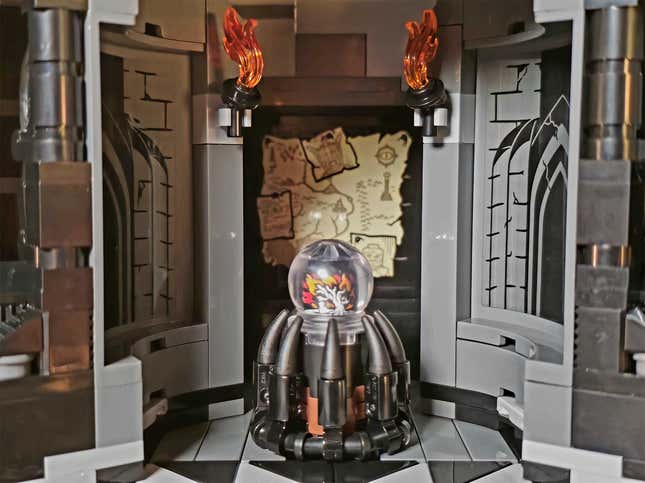
A nifty little feature of this section lets you pull a lever to split open Sauron’s throne, revealing a secret room with a palantir at its center—one side depicting the Scouring of the Shire, the other the white tree of Gondor aflame.
Behind that is a stickered map of Sauron’s other plans, which includes my second-favorite gag in the set: a scrap of paper which simply has written in faux-runic lettering “SHIRE? BAGGINS?” inspired by Gollum’s tortured revelation of the ring’s location. Love the idea of Sauron having a whiteboard he has to take notes on mid-interrogation.
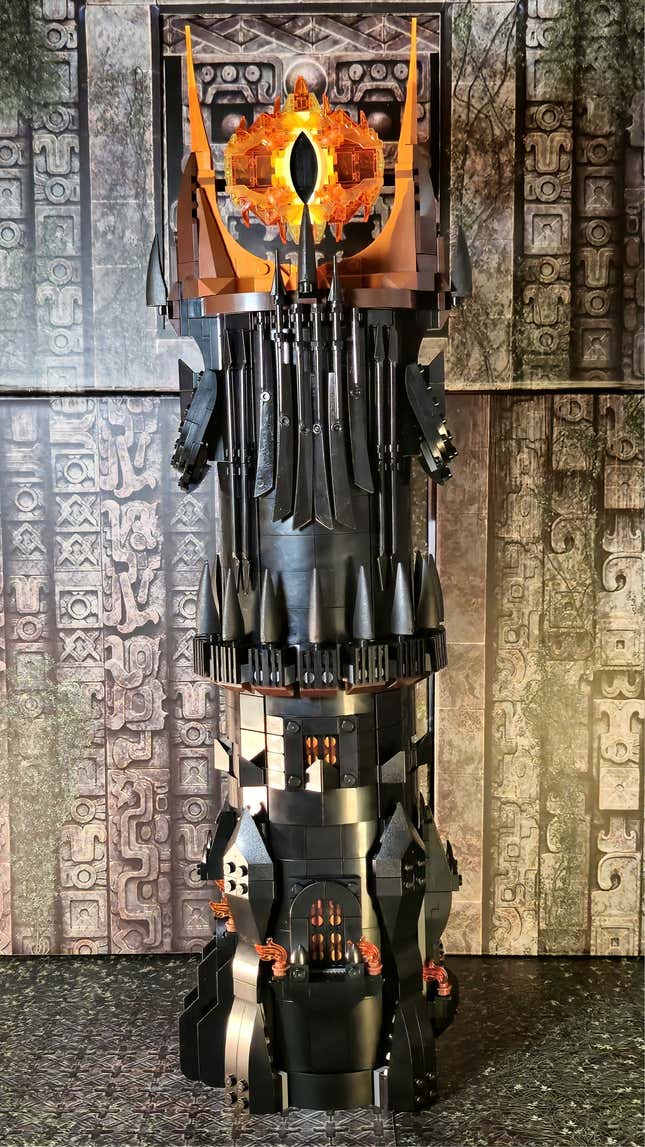
The last section of the build covers the actual spire of Barad-Dûr itself, and of course, Sauron’s lidless eye. It looks great: and brings back the use of orange and brown pieces around the tip of the spire to show the glow radiating from the Eye itself.
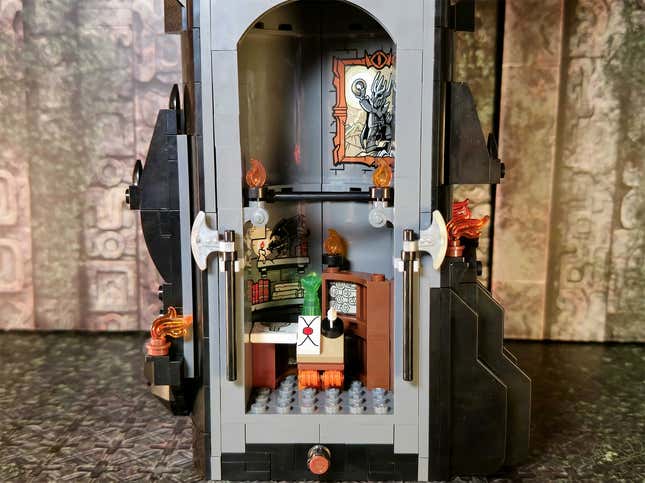
Although this is construced as one whole piece, there are actually two areas within the tower, as tiny and cramped as they are. The first is the apparent personal office of the Mouth of Sauron, which hilariously includes both a painting of his boss constantly watching over him, and a 1 x 1 tile piece depicting a vest of mithril: a reference to the Mouth’s scenes in the Extended Edition of Return of the King, where he shows the retrieved shirt to Aragorn and his gathered forces at the Black Gate, lying that Frodo has been found and killed.
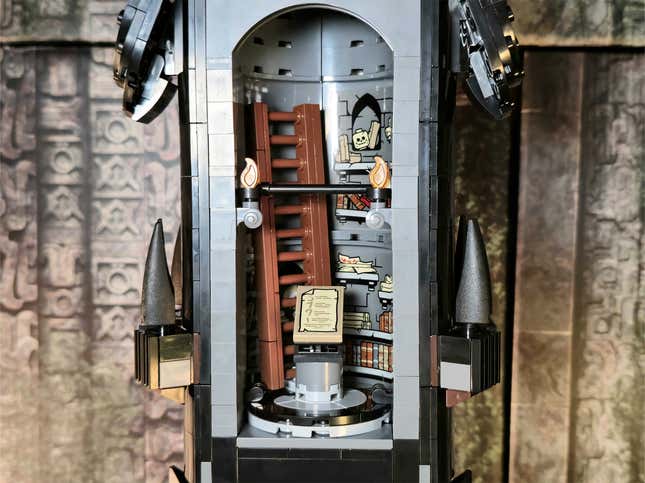
Just above that, and just as cramped, is a little library, for all those evil tomes Sauron apparently collected over thousands of years of plotting. The central plinth can be rotated to move the ladder about the space, but it’s very cramped.
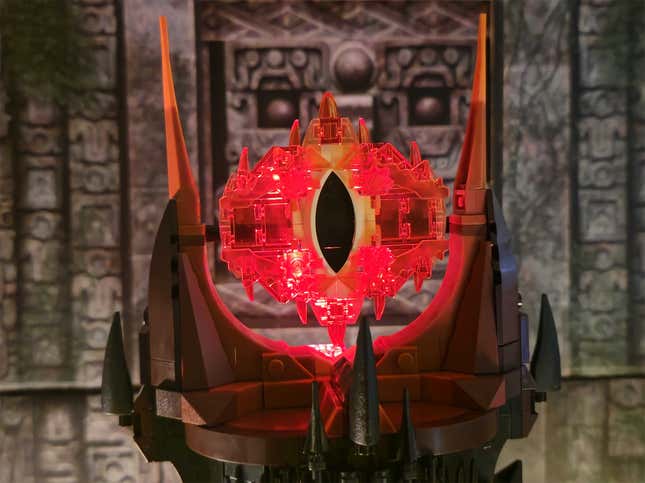
The light brick’s glow works best in low light conditions, but even then, it’s still a bit too red to make it really work for Sauron’s eye. The whole thing honestly looks better unlit without it.
That’s all our thoughts on Lego’s Barad-Dûr set—click through to see a few more pictures of the final tower on display, minifigures and all!
